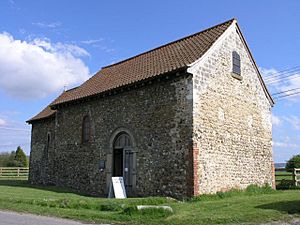St Benedict's Church, Paddlesworth facts for kids
Quick facts for kids St Benedict's Church, Paddlesworth |
|
|---|---|

St Benedict's Church, Paddlesworth, from the northwest
|
|
| Lua error in Module:Location_map at line 420: attempt to index field 'wikibase' (a nil value). | |
| OS grid reference | TQ 684 621 |
| Location | Paddlesworth, Kent |
| Country | England |
| Denomination | Anglican |
| Website | Churches Conservation Trust |
| History | |
| Dedication | Saint Benedict |
| Architecture | |
| Functional status | Redundant |
| Heritage designation | Grade II* |
| Designated | 25 August 1959 |
| Architectural type | Church |
| Style | Norman |
| Specifications | |
| Materials | Ragstone rubble Tiled roof |
St Benedict's Church is an old Anglican church located in Paddlesworth, Kent, England. It's a special building because it's no longer used for regular church services, but it's kept safe by the Churches Conservation Trust. This church is considered a very important historical building, known as a Grade II* listed building. You can find it along the famous Pilgrims' Way, about 1.6 kilometers (1 mile) west of Snodland.
A Look Back in Time
This church is very old! It was first built in the early 1100s, which is the 12th century. Some changes were made to it about 100 years later. In 1678, the church stopped being used for regular services. For about 250 years after that, it was used for other things. Since it was near a farm, it even became a farm building for a long time. The church was fixed up and made nice again in the early 1900s, and then again later in that century.
What the Church Looks Like
St Benedict's Church is built from a type of stone called ragstone rubble. It has a roof made of tiles. The church has a simple design with two main parts: a nave and a chancel. The nave is the main area where people would sit, and the chancel is the part near the altar.
The windows and doors of the church are rounded at the top. Inside, the church is quite plain. There's a gallery that was added in the 1800s. You can also see a cast iron candelabrum in the nave. This candelabrum is a large candle holder that dates back to the late 1600s.
More Places to Explore


